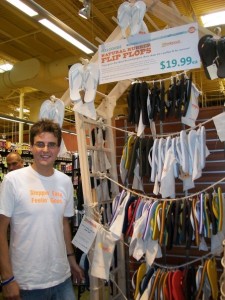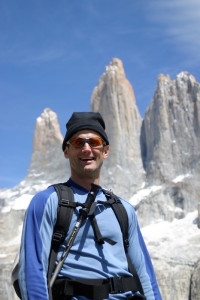Ruina Morales, right, and Christian Taylor, chemists with Applied Power Concepts in Anaheim, use a machine to measure the purity of ethanol. The company is a partner of cellulosic ethanol producer BlueFire Renewables in Irvine. (Allen J. Schaben, Los Angeles Times / November 18, 2010)
The area is attracting many companies focusing on green energy and transportation. It already boasts about 300 such firms with 20,000 jobs, business groups say.
Besides beautiful beaches, Disneyland and the original "Real Housewives" TV show, Orange County might have a new claim to fame.
The fastest-growing segment of the county's economy is now the clean-tech market, according to government and industry officials. Hundreds of green companies are settling in the area, long known for its real estate development and medical device industry.
The number of clean-tech jobs in the county, currently around 20,000, is growing about 5% each year, according to the Orange County Business Council. There are now nearly 300 clean-tech companies in the county, according to trade group CleanTech OC.
"The notion that it's an old, stodgy county is long gone," said Mike Levin, CleanTech OC's co-founder. "It's large, diverse and politically not what you think. Orange County is extraordinarily well-positioned to be a center — if not necessarily the center — of the clean-tech industry."
Nearby green hubs such as Los Angeles, San Diego and the desert cities are feeding business into Orange County. The roster includes hybrid-electric vehicle company Fisker Automotive Inc., solar services company DRI Energy and cellulosic ethanol producer Bluefire Renewables Inc., all in Irvine.
FlexEnergy, a clean-power company, is upgrading to a 30,000-square-foot office in either Santa Ana or Irvine that will be triple the size of the original. T3 Motion Inc., a Costa Mesa company that makes a three-wheel electric vehicle, is getting interest from security agencies and police departments and even had a cameo in this summer's blockbuster film "Iron Man 2."
Quantum Technologies Inc., a diversified clean-tech company in Irvine, will use a $4.4-million loan from California regulators to build a solar-panel manufacturing facility. Similar projects have pushed clean-tech industry production in the county up 54% since 1995, according to research group Next 10.
The region is also packed with companies like Santa Ana-based QuantumSphere Inc., which makes materials and components for longer-lasting batteries and for reducing auto and power plant emissions.
QuantumSphere co-founder Kevin Maloney, a UC Irvine graduate, helped launch the business from his brother's small Costa Mesa warehouse in 2002. Government funds and tax breaks now abound for clean-tech firms, he said.
"Orange County is typically known more as a software, hardware and biotechnology area," he said. "But there's a shift now that's been happening, a thrust towards more clean-tech-related companies."
Several universities are helping fuel the growth. UC Irvine is home to the Center for Solar Energy, the National Fuel Cell Research Center and the country's most advanced fueling station for hydrogen-powered cars. Two students recently won $25,000 from the X Prize Foundation's Crazy Green Idea contest with their concept for a new energy-storage system.
Even clean-tech companies outside the state — such as energy storage company Ice Energy in Colorado and Chicago-area energy efficiency company Lime Energy— are setting up satellite offices in Orange County to tap the growth.
"Orange County hasn't been known over the years as a center of clean-tech as opposed to places such as the Bay Area or Boston," said Brian Kremer, senior research analyst for clean-tech at Roth Capital Partners in Newport Beach. "But we're discovering more companies here than we had originally thought."
Having several major clean-tech investors based in the county has also helped. One of the country's leading clean-tech investors, David Gelbaum of Quercus Trust, lives in Newport Beach.
"Because the political climate is different than in a lot of other areas of the country, the clean-tech emphasis here has to be on economic growth and job creation and national security," CleanTech OC's Levin said. "It doesn't matter whether your top concern is global warming or not."
Automotive designers have been active in Orange County for years, making the advanced transportation industry with its electric and plug-in vehicles a leader in the region, experts said. And the long history of aerospace in the county resulted in a local workforce trained in science and technology, fields that translate well for the clean-tech market.
But sometimes its simpler reasons that have helped draw clean-tech companies to the county, like less traffic congestion.
Steering clear of Los Angeles traffic was key for clean-tech developer 808 Renewable Energy of Huntington Beach, which is gearing up for an initial public offering in the next few months.
"And we can get a great office space for less here than in Beverly Hills," Chairman Patrick S. Carter said. "There's a little more breathing room. It's a different culture."
Article by Tiffany Hsu, Daily Pilot
Besides beautiful beaches, Disneyland and the original "Real Housewives" TV show, Orange County might have a new claim to fame.
The fastest-growing segment of the county's economy is now the clean-tech market, according to government and industry officials. Hundreds of green companies are settling in the area, long known for its real estate development and medical device industry.
The number of clean-tech jobs in the county, currently around 20,000, is growing about 5% each year, according to the Orange County Business Council. There are now nearly 300 clean-tech companies in the county, according to trade group CleanTech OC.
"The notion that it's an old, stodgy county is long gone," said Mike Levin, CleanTech OC's co-founder. "It's large, diverse and politically not what you think. Orange County is extraordinarily well-positioned to be a center — if not necessarily the center — of the clean-tech industry."
Nearby green hubs such as Los Angeles, San Diego and the desert cities are feeding business into Orange County. The roster includes hybrid-electric vehicle company Fisker Automotive Inc., solar services company DRI Energy and cellulosic ethanol producer Bluefire Renewables Inc., all in Irvine.
FlexEnergy, a clean-power company, is upgrading to a 30,000-square-foot office in either Santa Ana or Irvine that will be triple the size of the original. T3 Motion Inc., a Costa Mesa company that makes a three-wheel electric vehicle, is getting interest from security agencies and police departments and even had a cameo in this summer's blockbuster film "Iron Man 2."
Quantum Technologies Inc., a diversified clean-tech company in Irvine, will use a $4.4-million loan from California regulators to build a solar-panel manufacturing facility. Similar projects have pushed clean-tech industry production in the county up 54% since 1995, according to research group Next 10.
The region is also packed with companies like Santa Ana-based QuantumSphere Inc., which makes materials and components for longer-lasting batteries and for reducing auto and power plant emissions.
QuantumSphere co-founder Kevin Maloney, a UC Irvine graduate, helped launch the business from his brother's small Costa Mesa warehouse in 2002. Government funds and tax breaks now abound for clean-tech firms, he said.
"Orange County is typically known more as a software, hardware and biotechnology area," he said. "But there's a shift now that's been happening, a thrust towards more clean-tech-related companies."
Several universities are helping fuel the growth. UC Irvine is home to the Center for Solar Energy, the National Fuel Cell Research Center and the country's most advanced fueling station for hydrogen-powered cars. Two students recently won $25,000 from the X Prize Foundation's Crazy Green Idea contest with their concept for a new energy-storage system.
Even clean-tech companies outside the state — such as energy storage company Ice Energy in Colorado and Chicago-area energy efficiency company Lime Energy— are setting up satellite offices in Orange County to tap the growth.
"Orange County hasn't been known over the years as a center of clean-tech as opposed to places such as the Bay Area or Boston," said Brian Kremer, senior research analyst for clean-tech at Roth Capital Partners in Newport Beach. "But we're discovering more companies here than we had originally thought."
Having several major clean-tech investors based in the county has also helped. One of the country's leading clean-tech investors, David Gelbaum of Quercus Trust, lives in Newport Beach.
"Because the political climate is different than in a lot of other areas of the country, the clean-tech emphasis here has to be on economic growth and job creation and national security," CleanTech OC's Levin said. "It doesn't matter whether your top concern is global warming or not."
Automotive designers have been active in Orange County for years, making the advanced transportation industry with its electric and plug-in vehicles a leader in the region, experts said. And the long history of aerospace in the county resulted in a local workforce trained in science and technology, fields that translate well for the clean-tech market.
But sometimes its simpler reasons that have helped draw clean-tech companies to the county, like less traffic congestion.
Steering clear of Los Angeles traffic was key for clean-tech developer 808 Renewable Energy of Huntington Beach, which is gearing up for an initial public offering in the next few months.
"And we can get a great office space for less here than in Beverly Hills," Chairman Patrick S. Carter said. "There's a little more breathing room. It's a different culture."












